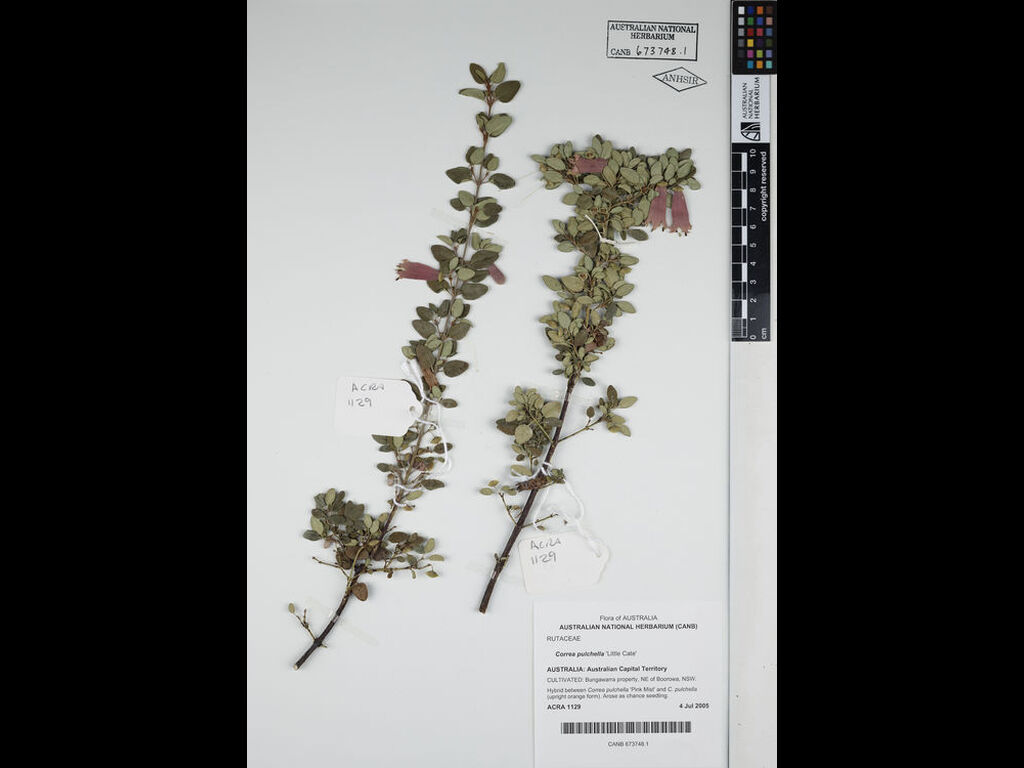Correa pulchella 'Little Cate'
- File Number
- 1127
- ACRA Field Book Number
- 1129
- Registration Date
- 31/03/2006
- Application Received
- 01/11/2005
- Family
- Rutaceae
- Cultivar Name
- Correa pulchella 'Little Cate'
- Origin
- Correa pulchella ‘Little Cate’ arose as a seedling in the garden of ‘Bungawarra’, a grazing property in the granite hill country northeast of Boorowa, NSW. The cultivar name was chosen as a diminutive of Catherine. The application was made by Cathy Hook and Paul Carmen in November 2005.
- Characteristics
- Correa pulchella ‘Little Cate’ is a moderately dense, spreading evergreen shrub which has grown to approximately 60cm high by 1m wide after 3 years in cultivation. Leaves are generally ovate to broad ovate, of variable size but up to 25mm long by 17mm wide. Flowers are a uniform bright pink. The corolla tube is 25mm long x 8mm wide. The flowers are profuse and prominently displayed, contrasting well with the dark foliage, and flowering continues for a long period. Peak flowering time is between April and July. Diagnosis: Thought to be a hybrid between two forms of Correa pulchella (a small leaved upright orange form and C. ‘Pink Mist’). C. ‘Little Cate’ differs from C. ‘Pink Mist’ in the colour of the flowers, which are a deeper/brighter pink and in its more spreading growth habit. The growth habit seems to be similar to C. ‘Dusky Bells’, however C. ‘Little Cate’ can easily be distinguished by its leaves which are darker green, thicker, and generally shorter and wider than those of C. ‘Dusky Bells’. The flowers of C. ‘Little Cate’ are also more prominently displayed and less concealed by the foliage.
- Cultivation
- This cultivar is easily propagated from cuttings and its cultivation requirements are the same for other selections of C. pulchella . It is both drought and frost hardy. It is worth noting that it has performed well in acid (pH 4.5) soil conditions.
- Publication
- Hitchcock, M. (2010), Correas: Australian Plants for Waterwise Gardens: 134-135
- Colour Coding
- RHS Colour Chart 1995 Flowers: Red Group 54A Leaves upper surface: Old leaves nearest to Green Group 139A; younger leaves 137ALower surface:138B
- Propagation
- Cuttings from semi-firm new growth
- Applicant Name
- Cathy Hook and Paul Carmen
- Uses
- As part of a mass planting or mixed in a shrubbery, or as a spectacular feature plant. Attracts nectar feeding birds.
- Availability
- Widely available, Kuranga nursery
- ANBG Accession Numbers
- ACC 1127, ACRA 1129, CBG 673748
- NSL ID
- -


